What is a Computer Memory:: It stores or saves instructions and results, and the results can be saved permanently as well as temporarily.
The data or instructions once saved can be retrieved or recalled or reviewed whenever the user demands.
They can store a huge amount of data and information as per requirements. The user can use the data whenever needs.
The Computer Hard Disk used as memory has the capability for storing volumes of data such as songs, movies, pictures, and software’s one can easily get access to this data whenever or wherever the user demands.
Users can rest sure of their data, as the data is stored almost permanently.
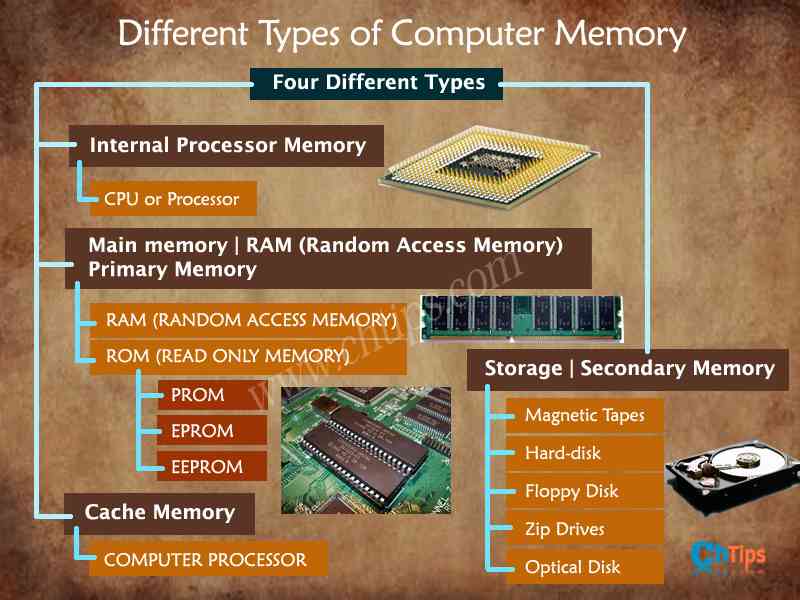
Different Types of Computer Memory
The computer memory can be classified in Four different types
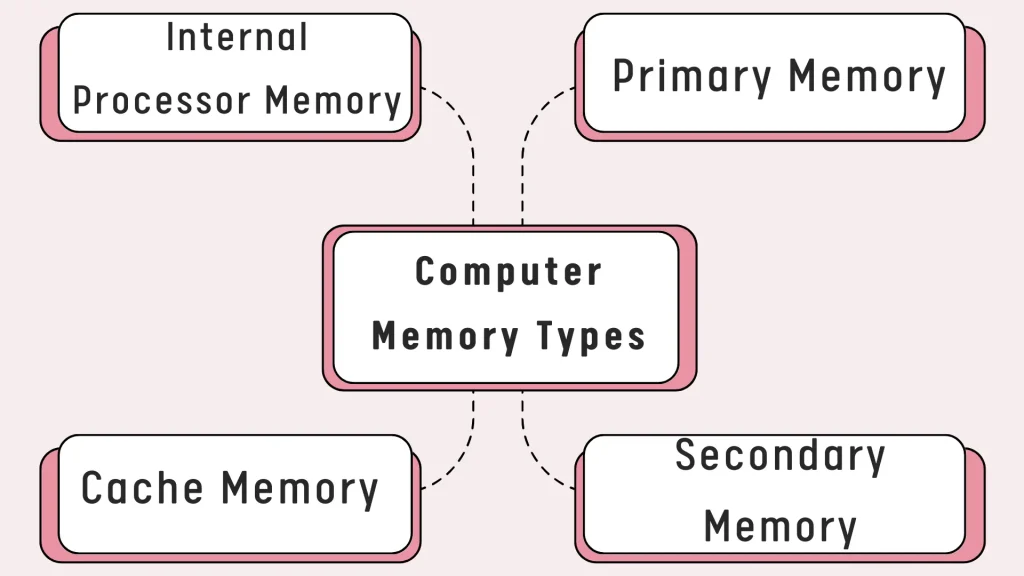
- Internal Processor Memory
- Main memory | RAM (Random Access Memory) | Primary Memory
- Cache Memory
- Storage | Secondary Memory
1. Internal Processor Memory.
These tiny high-speed registers live internally in a CPU or Processor, these registers are used and utilized in storing the data or instruction and information temporarily before the data is processed further where real processing and preparing takes place.
These registers are placed inside ALU and control unit, they are high-speed and perform arithmetical and logical operations at enormous speed.
They store or hold the data or instructions and information temporarily during the process, registers are extremely efficient.
Registers work under the control of the control unit for accepting and storing the data or instructions and information.
The speed or the processing and handling strength of the computer system relies upon the size, capacity, and limit of registers.
A few registers can hold up to 8 bits to 16 bits of data.
Yet with the improvement in cutting-edge innovation, the microchip or microprocessor has been created, designed, and developed to make the operation and applications work significantly speedier than some time before.
You May Also Like Reading
- What is Computer Fundamentals
- Advantages and Disadvantages of Computer System
- Basic Block Diagram of Computer
- Characteristics of Computer System
- Classifications of Computer
- Types of Secondary Memory in Computer
- Advantages and Disadvantages of Cache Memory
- Characteristics of Virtual Memory in Computer
- What are the Hard Copy Output Devices
- 12 Examples of Secondary Memory in Computer
- What is Buffered Memory and Their Differences
The more up-to-date microprocessor or a microchip can hold 32-bit to 128-bit registers, as this registers capacity of holding the data has been increased so the computer system speed for accessing, handling, preparing, and processing the data speed has been dramatically increased and expanded.
Different computer types uses and utilizes different types of registers relying on their size, abilities and capabilities.
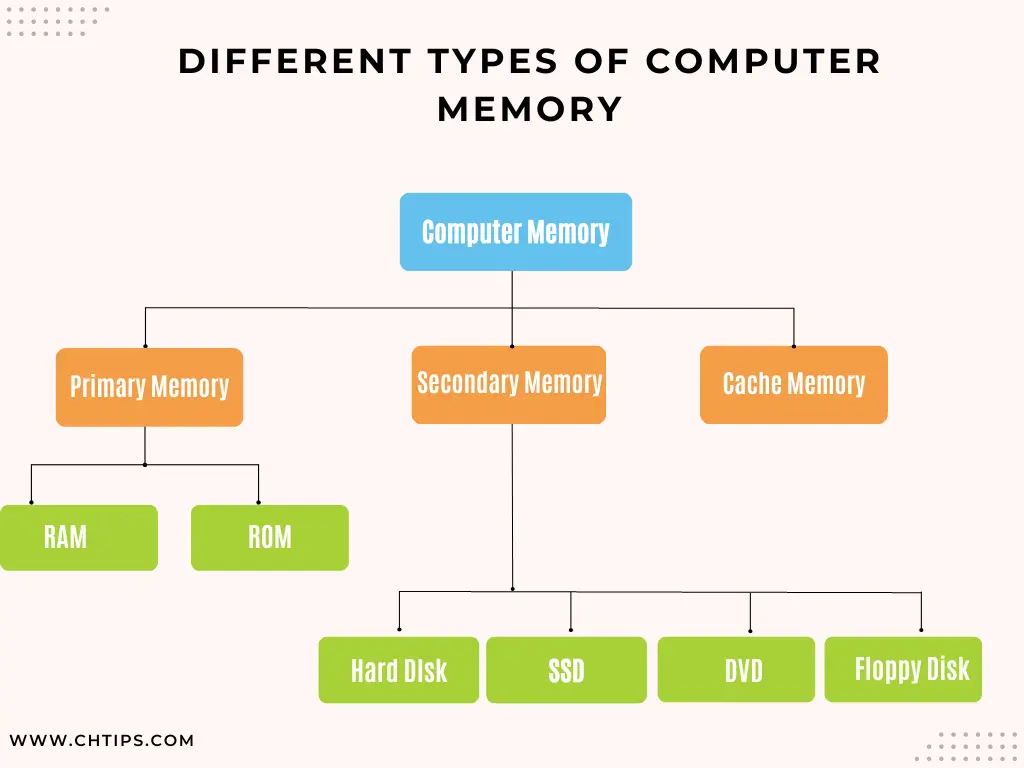
These cache memory stores the data and information temporarily and they are faster compared to main memory, as they reside or dwells inside the processor their speed of transferring the data to other location are faster than any other “computer memory“.
2. Primary or Main Memory.
Primary or Main Memory is additionally called “SEMICONDUCTOR MEMORY”.
This is likewise a Temporary memory that holds or saves data and information temporarily, as when there is a power failure or no power the data or information is lost.
They work or hold only on the present data which is being used and utilized by a computer system. They are not as fast as the registers.
The semiconductor memory is faster, smaller, lighter, and consumes less power compared to secondary storage.
They have a limited capacity, as well as they are very costly and can store only a couple of bytes of data.
They are essential memories to a computer if they are removed from a computer it fails to start or boot normally.
Each and every computer needs a primary memory to work properly.
The Capacity of primary memory is calculated in MB (Mega-Bytes) and GB (Giga-Bytes). nowadays they come in huge capacities ranging from 2 GB to 16 GB.
The main memory is further classified into two categories
- RAM (RANDOM ACCESS MEMORY)
- ROM (READ-ONLY MEMORY)
3. RAM (RANDOM ACCESS MEMORY)
The RAM Is known as “Random Access Memory”.
This is a volatile memory which means it cannot store or saves the data or instruction or set of information once the power is off.
They are fast, less expensive & light.
RAM can transfer or exchange data from and to the CPU considerably speedier than secondary storage.
The RAM is placed inside the computer system to be precise they are installed on a computer motherboard and it is also a primary reason for computer speed.
It is used for storing all active programs or instructions with the goal that it can be additionally exchanged for CPU for the additional process.
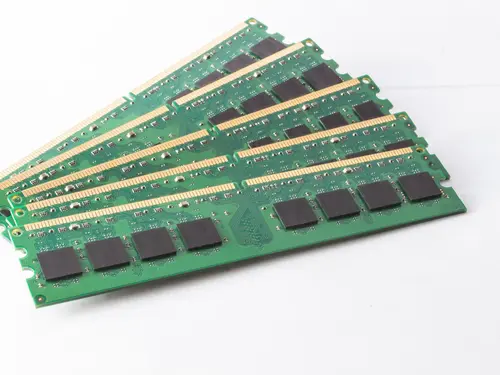
The technology used in RAM is based on semiconductor integrated circuits. RAM is divided into two more categories
- Static Ram
- Dynamic Ram
Static RAM:: The static Ram stores binary information in clocked sequential circuits. It is comprised of flip-flops and stores a touch of voltages.
It is a volatile or unstable memory if the power is from the data or instructions is destroyed. This kind of memory does not require refreshing.
Dynamic RAM:: Dynamic RAM stores binary information in the form of electric charges that are connected to capacitors that are inside the chip.
This type of Ram Consumes less power and is capable of storing or holding more data and information compared to static RAM.
4. ROM (READ-ONLY MEMORY).
ROM Stands for “READ ONLY MEMORY” they are non-volatile or non-unstable if the power is off they can still store the data permanently.
They can be used as permanent storage.
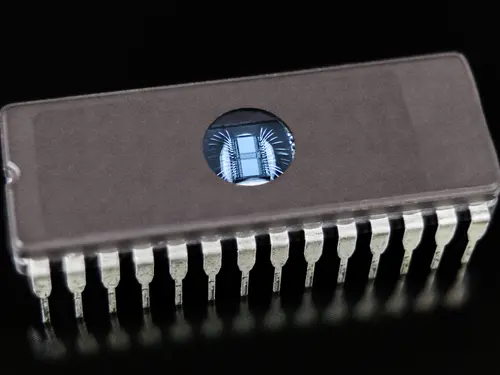
Users can not manipulate the data which is inside this memory only the manufacturer or programmers writes programs or instructions inside them.
which are used to boot the computer or operating systems when the computer is powered on.
ROM are of different Types
- PROM
- EPROM
- EEPROM
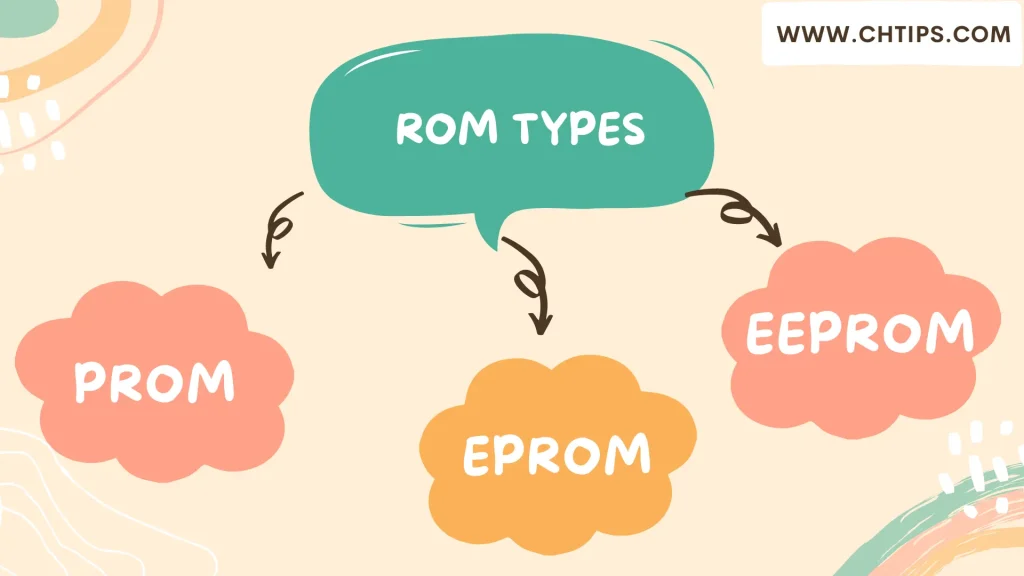
1. PROM.
PROM stands for “Programmable Read-Only Memory” it is also a type of non-volatile memory.
which once programmed or customized then the set of instructions or information stored cannot be deleted or updated or refreshed.
Computer Programmers or software developers write and compose programs or codes in this chip in such a fashion to receive the desired functionality, special equipment is used to write programs inside the chip.
2. EPROM.
EPROM stands for “Erasable Programmable Read-Only Memory”.
As the name suggests, the programs which had been written and composed by computer programmers can be deleted or updated according to the necessities.
One needs to uncover this chip to High Ultraviolet light for over 20 minutes to delete the information.
Once exposed, they can be reused after reprogrammed
They should not be overexposed to avoid damage.
You cannot delete or erase a single piece of content from them. If you try to do it, the whole data or information inside the chip gets deleted or erased.
This type of memory is broadly used as they are cheap and reliable.
3. EEPROM.
EEPROMS stands for “Electrically Erasable Programmable Read-Only Memory”
To erase or delete the information or data inside them, one should take the memory outside the PCB (Printed Circuit Board).
As the time required for erasing the information is significantly speedier the EPROMs.
You May Also Like
- The Five Generations of Computer
- A Brief History of Computers
- Input Devices of Computer
- Output Devices of Computer
- What is a Computer Virus and its Different Types
- Computer Basic Tutorials
CACHE MEMORY of Computer System
Cache memory dwells between primary memory and CPU [Central Processing Unit]. It is extremely expensive therefore, the manufacturer uses it in low numbers.
They are fast and reliable. They are likewise called high-speed semiconductors.
They are primarily responsible for accelerating the CPU.
They hold or store the data which is frequently used by “COMPUTER PROCESSOR”.
This program or information is transferred and exchanged from disk to cache memory with the assistance of the operating system so that Processor can access them.
They are considerably much faster than the main memory, and the data exchanging time is less than the main memory.
This is one of the fastest computer memory used in computer systems.
The powerful computer uses more cache memory to speed up the information transfer and exchange process.
10 Characteristics of Primary Memory
| # | Characteristics of Primary Memory |
| 1 | They are faster memory than the secondary memory of computers. |
| 2 | They are expensive. |
| 3 | The data and information can be transferred from one location to another quickly and accurately. |
| 4 | They can be accessed directly with the CPU {Central Processing Unit}. |
| 5 | They are the most essential memory in computer systems. |
| 6 | They are volatile in nature. The data and information, once lost can not be recovered. |
| 7 | They are volatile in nature. The data and information, once lost, can not be recovered. |
| 8 | They are crucial Memory of computer system & the computer cannot function correctly without them. |
| 9 | They are compact. |
| 10 | The primary Memory of a computer system holds all the major applications of OS. |
Functions of Primary Memory
- Primary Memory can communicate directly with the CPU [Central Processing Unit] without any intervention.
- They are built to store data, instruction, and information currently being processed.
- They stored data and instructions temporarily.
- The operating system’s crucial and important files temporarily dwell inside the main or primary memory for system start-up or booting.
- Application Software and Utility Software require primary memory for proper functionality.
Examples of Primary Memory
There are various examples of primary memory that are mentioned below.
- RAM
- ROM
- SDRAM
- DRAM
- SRAM
- PROM
- EPROM
- EDORAM
- DDR SDRAM
People Are Also Reading
- What is Computer Hardware and Software
- What is a Computer Motherboard
- Different Types of Motherboard
- What is Operating System and Its Different Types
- Differences Between Internal And External Memory
- Computer Memory in Hindi
Storage Memory | Secondary Memory of Computer
Secondary Storage is also called “AUXILLARY MEMORY”.
They are also called “PERMANENT MEMORY” as they are non-volatile in nature.
The data stored in them is stored permanently, and the user can access their data any time the user requests.
If the power is off, they still don’t lose the data because of its non-volatile nature.
They are the slowest and the least expensive type of PC memory as they can’t directly and straightforwardly get access to the CPU.
They utilize the primary memory for storing and holding their information partially.
They can store large volumes of data permanently, and whenever the computer system requires the data, it can be served as primary memory for advanced processing.
The different types of secondary Memory which are used in computer systems
- Magnetic Tapes
- Hard-disk
- Floppy Disk
- Zip Drives
- Optical Disk
Types of Secondary Memory
- Fixed Storage
- Removal Storage
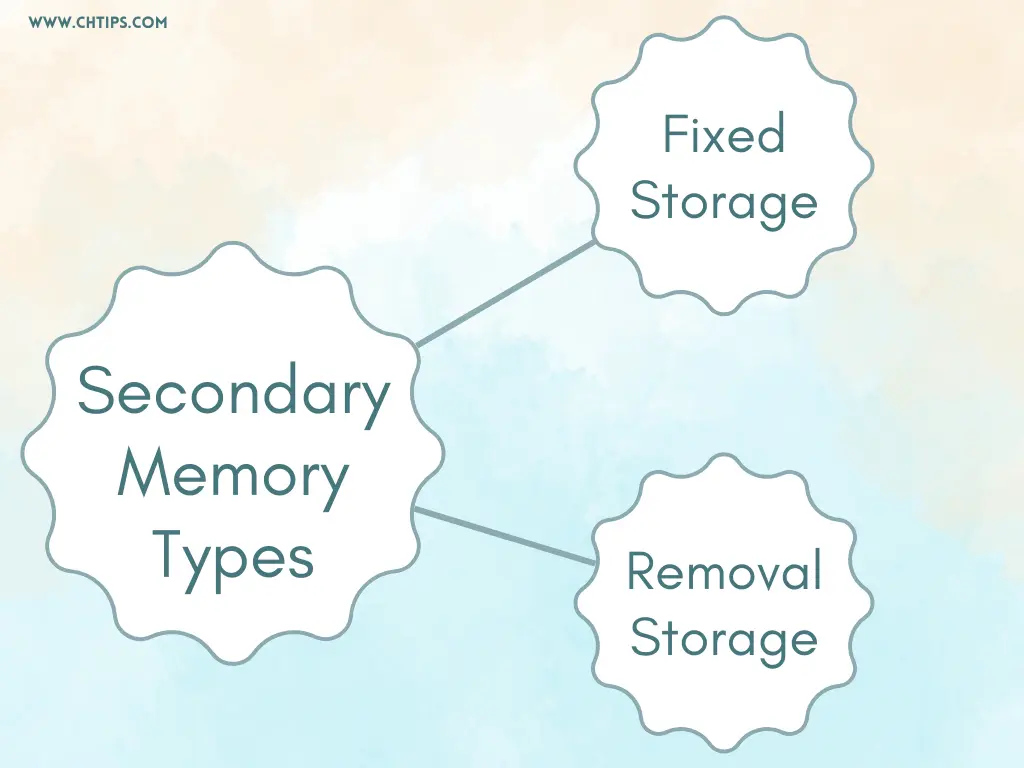
Examples of Secondary Memory
- SDD [Solid State Drives]
- Flash Drives
- NAS [Network Attached Storage]
- SAN [Storage Area Network]
- Cloud Storage
- Magnetic Tapes
- Magnetic Disk
- Hard-Disk
- Floppy Disk
- Zip Drives
- Optical Disk
- Pen Drives
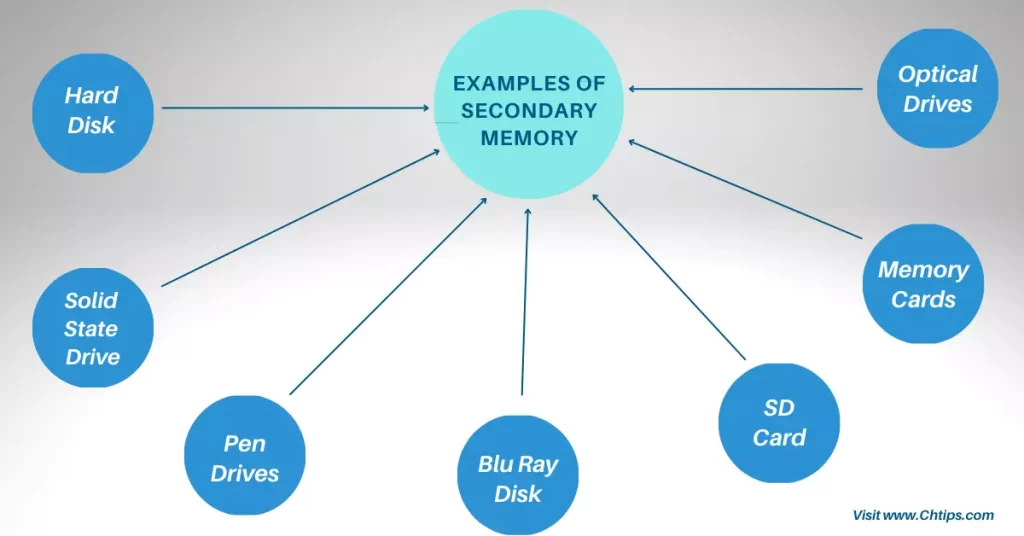
Useful Video On : What is a Computer Memory and Its Type
7 Characteristics of Secondary Memory of Computer System
| # | Characteristics of Secondary Storage Devices |
| 1 | Secondary Storage Memory is non-volatile. |
| 2 | They are fast memory but not as speedy as primary memory. |
| 3 | The data and information stored in secondary memory like a hard disk or SSD can be saved permanently. |
| 4 | They are inexpensive compared to primary memory. |
| 5 | They are portable and can be transferred from one location to another. |
| 6 | They can store data in any form, like songs, movies, software, files, etc. |
| 7 | They are readily available in the market with different storage capacities. |
Advantages & Disadvantages of Cache Memory
| # | Advantages | Disadvantages |
| 1 | A cache is faster and has smaller memory and is used more frequently. | Expensive memory compared to others. |
| 2 | A primary cache has a less access time comparable to a processor register and it is always placed on the processor chip. | It is a Volatile Memory. |
| 3 | It is generally placed between the primary cache. | The storage capacity is completely in use. |
| 4 | Cache memory is high-speed semiconductor memory that is responsible for the CPU. | The increased chip area is required for the memory system. |
| 5 | It consumes less access time as compared to main memory. | Cache data is stored as long as the computer power is on. |
Differences Between Internal & External Memory
| # | Internal Memory | External Memory |
| 1 | Internal memory is Volatile. | External memory is Non- Volatile. |
| 2 | Also Known as “Primary Memory” or “Main Memory” or “Semiconductor Memory”. | External or secondary memory is also called “AUXILLARY MEMORY” and “PERMANENT MEMORY.” |
| 3 | They are installed internally. | They are attached using cables and wires. |
| 4 | Low Storage Capacity. | Enormous Storage Capacity. |
| 5 | They are faster compared to external memory. | They are slower than internal memory. |
| 6 | Examples of internal memory RAM (RANDOM ACCESS MEMORY) ROM (READ-ONLY MEMORY) | Examples of Secondary storage Computer Hard Disk Drive. Pen Drives. SSD {Solid State Drives}. Optical Disks. Cloud Storage |
| 7 | They are expensive. | They are cheaper. |
Top Memory Manufacturer
Frequently Asked Questions [FAQs] on Computer Memory
What are the 3 Types of Computer Memory?
Primary Memory
Secondary Memory
Cache Memory
What is ROM Type of Memory?
Read-only memory (ROM) is a type of non-volatile memory
What Type of Memory is BIOS?
The BASIC INPUT OUTPUT SYSTEM [BIOS] is a program that is installed in a ROM [Non-Volatile Memory].
Which Memory Speed is the Fastest?
The Speed of Cache Memory is the Fastest.
What are Four 4 Types of Memory in a Computer?
RAM, ROM, CMOS, and Flash
Types of ROM
MROM, PROM, EPROM, EEPROM, Flash Memory
What is the Unit of Memory?
Bits and Bytes
What is the Highest Memory of a Computer?
A yottabyte
Get In Touch
I have also written and compiled some articles on computers and telecommunications, and please go through them.
I hope you will like reading it.
All the questions and queries related to What is a Computer Memory Definition has been answered here.
If you have any questions related to Different Types of Memory Computer System
Don’t hesitate to contact me, and if you need to add, remove, or update anything from the article, please let me know in the comment section or via email.
I will be more than happy to update the article. I am always ready to correct myself.
I would like you to share this article with your friends and colleagues; this motivates me to write more on related topics.
!! Thank You For Reading !!